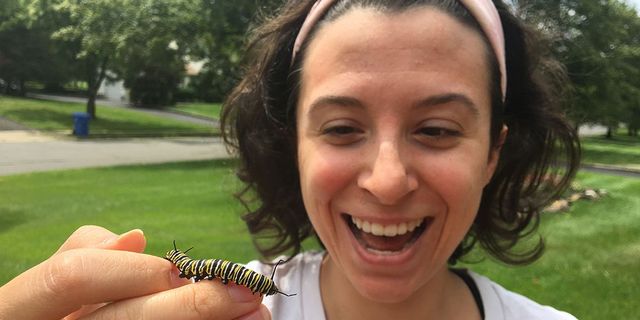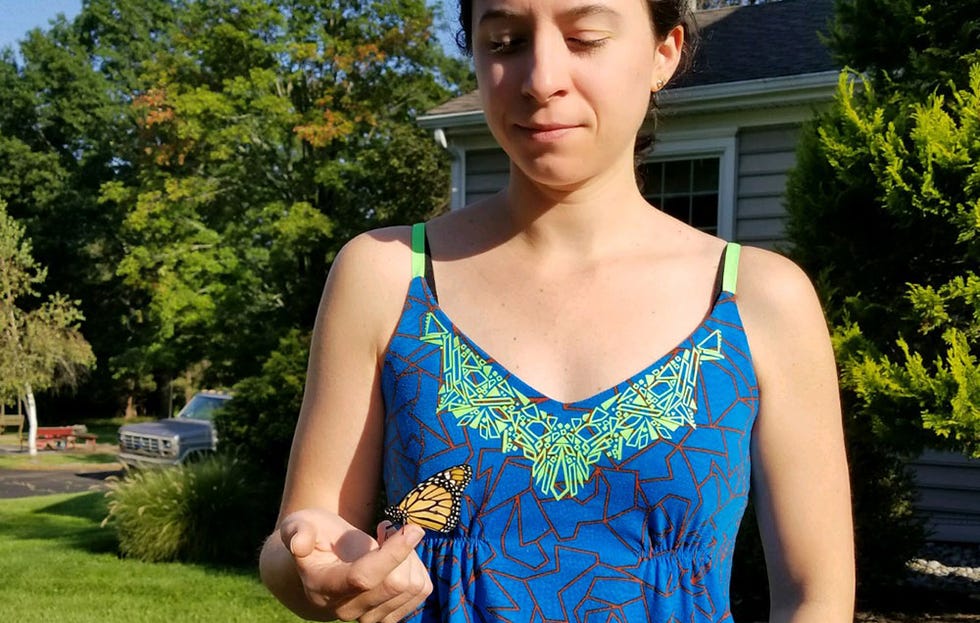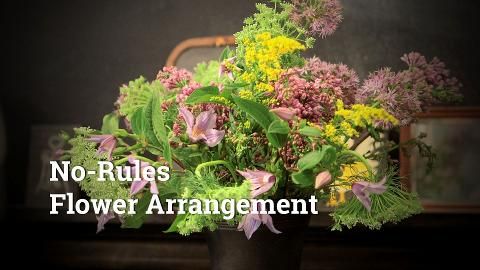We can all use a bit more magic in our life: something like the warm appreciation of watching a butterfly flying through a garden, or the giddiness of catching a real-life, very hungry caterpillar munching his way through milkweed.
Related: 5 Surprising Ways Gardening Improves Your Health
If you’re anything like me, these moments fill you with contentment and wonder. It’s with this sense that I set out to learn more about how to raise monarch butterflies. The species population is rapidly decreasing and in need of people willing to help. The Department of U.S. Fish and Wildlife warned in 2014 that the number of monarchs had dropped from 1 billion to 33 million. Monarchs are beautiful, and they also help the planet: while feeding on nectar, they pollinate many types of wildflowers.
(Like what you're reading? Sign up for our newsletter to get health insights, clever kitchen tricks, gardening secrets, and more—delivered straight to your inbox. And follow along on Facebook and Instagram.)
Monarch populations are in danger
The main cause of decreasing monarch numbers is habitat loss, whether that’s in the Midwest or Mexico. When temperatures start to drop around October, Monarchs migrate over 3,000 miles to the Oyamel Fir Forest in Mexico or to eucalyptus trees in Pacific Grove, California (less popular) to ‘overwinter’.' What’s more awing is that each season, four or five generations of monarchs are born. "The final generation is physiologically different than earlier generations,” says Rhonda Fleming Hayes, author of Pollinator Friendly Gardening: Gardening For Bees, Butterflies and Other Pollinators.
Daylight and an internal compass trigger this migration, causing them to land in the same protective trees every year. Sadly, their safe habitats are decreasing due to illegal logging of monarch-friendly trees, and increasingly common large storms which destroy these safe environments. The butterflies that survive migrate north where another hurdle awaits them. Monarchs exclusively lay eggs, breed, and mature on milkweed plants, which happen to grow in abundance in Midwestern agricultural areas, and is also poisonous to other insects—which is why monarchs are marked with bright colors as a warning.) But, because conventional farming increasingly uses more pesticides (in part to keep up with the demand of Monsanto GMO “round-up ready” corn and soybean crops), it damages milkweed supply.
The use of herbicides along highways and power lines, and even just mowing these areas, has also killed off a large chunk of their habitat. “If managed appropriately, roadsides could provide millions of acres of habitat suitable for monarchs and other pollinators,” explain the experts at the Monarch Joint Venture.
Related: The Most Pesticide Laden Produce of 2017
Monarchs Thrive On Milkweed And Nectar Plants
If you want to help without raising the butterflies yourself, planting milkweed always benefits monarchs. “There are many species of milkweed,” says Hayes. “Orange or yellow butterfly weed (Asclepias tuberosa) is well-behaved in perennial gardens, Swamp or rose milkweed (Asclepias incarnate) is a taller pink variety that is quite adaptable to different soil and moisture conditions, and common milkweed is coarser in habit and can spread, however the pale pink globe shaped flowers are wonderfully fragrant.”
Check out the video below for beautiful, no-rules flower arrangement:
You can also consider planting nectar, especially important for pollinators around this time of year, like anise hyssop (Agastache foeniculum), Mexican sunflower (Tithonia), zinnias (tall varieties), Brazilian verbena (Verbena bonariensis), Blazing star (Liatris), especially Meadow blazing star (Liatris ligulistylis), and Bottlebrush (Callistemon).
Related: Grow These 50 Pollen-Rich Plants To Help Your Local Honeybees
Below, our guide for how to raise monarch butterflies indoors.
Search For Eggs And New Monarch Caterpillars
Raising monarchs is a great hobby to get closer to nature, or to teach kids about an eco-system (Here are 3 amazing ways gardening is good for kids.) Hoping to find a local monarch rearing organization, I searched for eggs or caterpillars to have sent via mail. But the Monarch Joint Venture changed my mind. “Indoor rearing is likely to save wild-caught individuals from voracious predators, can have positive educational outcomes, and can contribute to our understanding of monarchs,” they explained, “But we do not recommend captive breeding or purchasing commercially reared monarchs for release as a means to supplement the natural monarch population.”
Related: How To Create The Best Garden To Attract Butterflies
That evening on my walk I noticed a few stalks that looked like the milkweed I’d seen in my research. Remembering monarchs lay their eggs exclusively on the plant, I decided to hop my way into the brush and peek under a few leafs. Munching happily were newborn monarch caterpillars no bigger than my pinky fingernail. Their stripes were faint but unmistakable. I did a little dance in the woods.
To find these monarch babies yourself, the first step is knowing what milkweed looks like. Once located (check local, sunny fields), peek underneath the leaves for a small, yellow dot. This is a monarch egg. They usually only lay one per leaf from early spring to late summer. Babies already hatched are smooth and have yellow, black, and white stripes. They are teeny! If you find a leaf crowded with caterpillar larva, you have not hit the monarch jackpot (I made this mistake and quickly returned them to the patch). It’s likely a Milkweed Tussock Moth—not quite what we’re going for.
Related: Why The Butterfly Bush Gets A Bad Rap
Set Up A Clean Tank
Look around your home for out-of-service fish tanks or bug containers. You can alternatively order a mesh pop-up net. The more space you can provide, the less chance for spreading disease. I cleaned a 5-gallon glass fish tank with a 20% bleach solution, lined the bottom with a clean towel, and placed it in a window that gets indirect sunlight. Beware not to place a tank in direct sunlight or by a vent. Also consider adding a few sticks to prop up stalks of milkweed.
Forage For Milkweed
Monarchs solely eat milkweed, so be sure to have a large supply (15-20 stalks) available. Milkweed is poisonous to other insects and animals, making the monarchs also poisonous for most animals to eat, which is why they are so brightly colored (signaling "Danger!) At first, I attempted to replant whole plants in my yard, but they have taproots, which made it tricky and super unsuccessful. Now, once a week I bring a brown paper bag and a pair of scissors to clip about 5 stems varying in size from a local field where they grow wild.
When foraging, it’s imperative that you examine every leaf and stalk before clipping. Lots of other critters like laying eggs on milkweed and you don’t want to introduce them to tank. (But, we are dealing with nature here, so expect the rogue insect or two. It’s part of the experience.) Once home, I clip the stems on an angle, rinse the leaves, and plop them in small, recycled glass jars full of water in the tank. Be sure to wash your hands after handing milkweed, as it’s irritating to eyes.
Related: 26 Plants You Should Always Grow Side-By-Side
Week 1
I foraged about eight caterpillars from a local field, and either clipped off the leaf they were on or cut the whole stalk to add to the tank. I’ve gave up trying to locate them all, but I could tell they were there because I could see more and more tiny holes in the original milkweed plant.
I added a few small jars with fresh milkweed clippings and some leaves on a plate. (If you’re only going to provide leafs, make sure to place them on a damp towel and replace often.) By the end of week one they are at least four times their original size. They’ll be caterpillars for about 10-14 days, so they have lots of growing to do. I’m astonished and also slightly jealous that their plan in life is to eat a ton, then become beautiful butterflies
Related: 7 Fruits That Taste Better When You Pick Them In The Wild
Week 2
So. Much. Poop. I changed the towel at the bottom of the tank and, I kid you not, an hour later it was covered in tiny dark green pellets. But it’s important to keep their space clean to avoid disease. I’m still amazed at how fast they’re growing. I picked up a few water tubes and a piece of foam from my local florist to keep the clipped milkweed standing straight up. This way, clippings last over a week (unless fully eaten) and I top off the tubes with water about every other day.
The original milkweed stem was still in the tank, but more and more caterpillars are seeking new leaves as it dries and curls—though they do love hiding in a good leaf curl. I arranged all the clippings so they are touching. I also found two brand new tiny little caterpillars in the tank. There were a few eggs on the milkweed clippings I brought in last week. Welcome to the family!
Week 3
Big news this week: One caterpillar had attached himself by silk thread on the underside of a leaf to pupate. This did come at a very inconvenient time (the morning I scheduled to clean the tank). But, carefully removed the plant he was hanging on and placed him in a safe spot while cleaning. It’ll take him about 24-36 hours to become a chrysalis. At this point, there’s not much hide-and-seek with the caterpillars. They are big, and fat, and munching away in visible sight.
One of their defense mechanisms is actually quite comical: they freeze mid-chew when I walk up to the tank as if I can’t see them. Also they are molting all over the place—a snake-like shed they do about five times when growing. So if your caterpillars are on the top or side of the tank motionless, they are likely molting. Let them do their thing. Also, I’m running through milkweed pretty quick these days. I replenish and clean the tank about every three days. (The poop is getting bigger too.) Now that the crew is on the move, I cut larger stalks and overlap the entire tank with milkweed. It’s like a mini-jungle.
Related: The 11 Most Amazing Bugs That Benefit The Whole Ecosystem
Week 4
All of the original caterpillar crew have formed beautiful milky green chrysalises with golden spots on the top of the tank. Experts don’t know even what the gold is or it’s function. From here, they’ll take about 9-14 days to mature into butterflies. A few babies have attached themselves to dying leafs so I gently pulled them off and tied them up to the top of the tank with, believe it or not, dentil floss, to prevent them from falling down. It was nerve-wracking. Definitely not a beginner task but it needed to be done. At this point I was raising about seven caterpillars so the tank was generally green with milkweed, and significantly more difficult to clean. But I was up for the challenge.
Related: Your Bee Friendly Garden Could Be Killing Bees—Here’s How To Fix It
Week 5
Believe it or not, the day I sat down to write about my experience, the first butterfly hatched. The chrysalis slowly faded from a jade green to clear, revealing orange wings. When the butterfly came out his wings were rippled and wet. It was incredible to watch him fan off and straighten out. How big he was after a few minutes! I left him alone for the recommended 4-5 hours before adding a few stems of Butterfly Bush (Buddleia davidii) for him.
I also mixed up some sugar water in a small bowl with a cotton pad. It’ll likely take him a day to eat. Adult monarchs live about 2-6 weeks in the summer, if they are the generation to migrate, and 6-9 months through the winter. Three other pupa are clearing up.
I plan to let them emerge before releasing them together in my garden during a sunny day. Maybe they will make their way to Mexico and maybe they will lay more eggs. No matter what, I know I did my little part in helping the monarch population. And next year? I’ll do it all over again.














